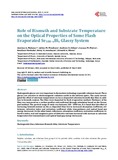| dc.description.abstract | Chalcogenide glasses are very important in the modern technology especially selenium-based. These glasses are sensitive to electromagnetic radiation useful in the infrared optics. The study investigated the effect of substrate temperature on the as-deposited selenium-bismuth thin films in addition to bismuth content. The films were deposited by flash evaporation method. Thickness of the films was measured on a surface profiler and confirmed through calculation based on the Swanepoel method. The spectral range of study was between 200 - 3000 nm. It is found that the effect of increasing bismuth content on the as-deposited films led to increased absorption coefficient, reflectance, refractive index and extinction coefficient while transmittance and optical band gap energy decreased. On the other hand, reflectance, absorption coefficient, extinction coefficient, refractive index, real and imaginary parts of dielectric constant increased with increase in substrate temperature but transmittance and optical band gap energy decreased. | en_US |

